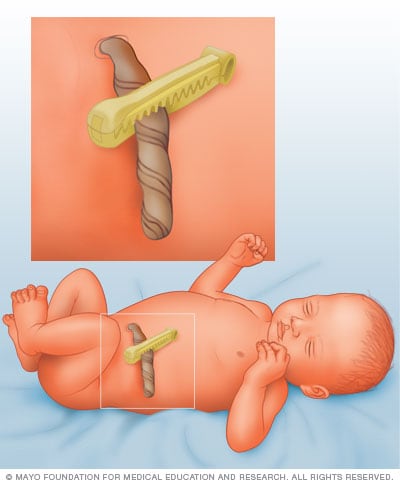Umbilical cord care: Do’s and don’ts for parents
A newborn’s umbilical cord stump typically falls off about two weeks after birth. In the meantime, treat your baby’s umbilical cord stump gently.
Wonder how to care for the umbilical cord stump attached to your newborn’s belly button? Follow these tips to help with healing.
Why your baby has an umbilical cord stump
Umbilical cord at birth
Umbilical cord at birth

Umbilical cord at birth
After birth, the umbilical cord is clamped and snipped.
The umbilical cord brings nutrients and oxygen to your baby during pregnancy. After birth, the umbilical cord isn’t needed anymore. So, a healthcare professional clamps and cuts it soon after your baby is born. This leaves behind a short stump.
Taking care of the stump
A baby’s umbilical cord stump needs to dry up before it falls off. Most often, the stump falls off 1 to 3 weeks after birth. In the meantime, treat the area gently:
- Keep the stump dry. Expose the stump to air to help dry out the base. Keep the front of your baby’s diaper folded down, so it doesn’t cover the stump. Or cut off a small piece of the diaper with scissors and use tape to seal the edge. Half of the strip of tape goes on the inside of the diaper, and half sticks to the outside of the diaper.
- Don’t swab the stump with rubbing alcohol. Do not use this on the stump unless your healthcare professional tells you to do so.
- Clean up any fluids around the stump. Clear or blood-tinged fluids may seep out around the umbilical cord stump. If you notice any, clean them off with a wet cotton swab. You may need to gently push down on the skin around the cord stump to reach all the fluids. You also might need to slightly bend the cord stump. Then, pat dry with a clean cloth. Expose the cord stump to air.
- Clean up any stool that gets on the cord. This can help prevent infections. Use a washcloth that has soap and water on it to clean the dirty part of the cord. Pat it dry with a clean cloth and keep the stump exposed to air.
- Stick with sponge baths. These might make it easier to keep the stump dry than a regular bath would. During a sponge bath, you wipe or dab areas that need to be cleaned. Use a warm, damp sponge or cloth. You can put a bit of bath wash on it if you want. Then, rinse the areas you cleaned with a wet sponge or cloth. Dry with a dry towel or washcloth. If you get the umbilical cord stump wet, that’s okay. There’s no harm in getting the stump wet.
- Let the stump fall off on its own. Do not pull off the stump yourself.
When to call your baby’s healthcare professional
It’s common for the stump of the umbilical cord to change color before it falls off. It’s also typical to see a little blood near the stump. For instance, a tiny amount of bleeding could happen if the stump catches on something. Or it might happen if the diaper rubs against it. And much like a scab, the stump might bleed a little when it falls off.
But you should call your baby’s healthcare professional right away if:
- Bleeding from the stump gets worse, or you still notice a few drops of blood after three days.
- The umbilical area oozes thick fluid, especially if it’s yellow. This is called pus.
- The area becomes red or red-streaked. This symptom of infection can be hard to see on darker skin. So, feel the skin. Infected skin often feels warmer than skin that is not infected.
- The area is tender, swollen or foul smelling.
- Your baby gets a fever, becomes very tired or irritable, or feeds poorly.
These could be symptoms of an umbilical cord infection. Prompt treatment is needed to stop the infection from spreading.
Also, talk to your baby’s healthcare professional if the stump still hasn’t fallen off after three weeks. Your baby might need treatment for a medical issue such as an infection or an immune system condition.
There is a problem with information submitted for this request. Review/update the information highlighted below and resubmit the form.
Children’s health information and parenting tips to your inbox.
Sign-up to get Mayo Clinic’s trusted health content sent to your email. Receive a bonus guide on ways to manage your child’s health just for subscribing. Click here for an email preview.
To provide you with the most relevant and helpful information, and understand which information is beneficial, we may combine your email and website usage information with other information we have about you. If you are a Mayo Clinic patient, this could include protected health information. If we combine this information with your protected health information, we will treat all of that information as protected health information and will only use or disclose that information as set forth in our notice of privacy practices. You may opt-out of email communications at any time by clicking on the unsubscribe link in the e-mail.
Thank you for subscribing
Our e-newsletter will keep you up-to-date on the latest health information.
Something went wrong with your subscription.
Please try again in a couple of minutes
Feb. 10, 2024
.



